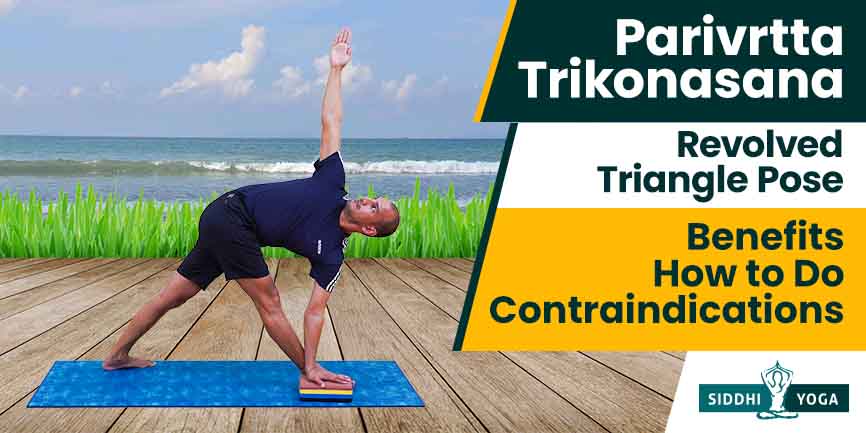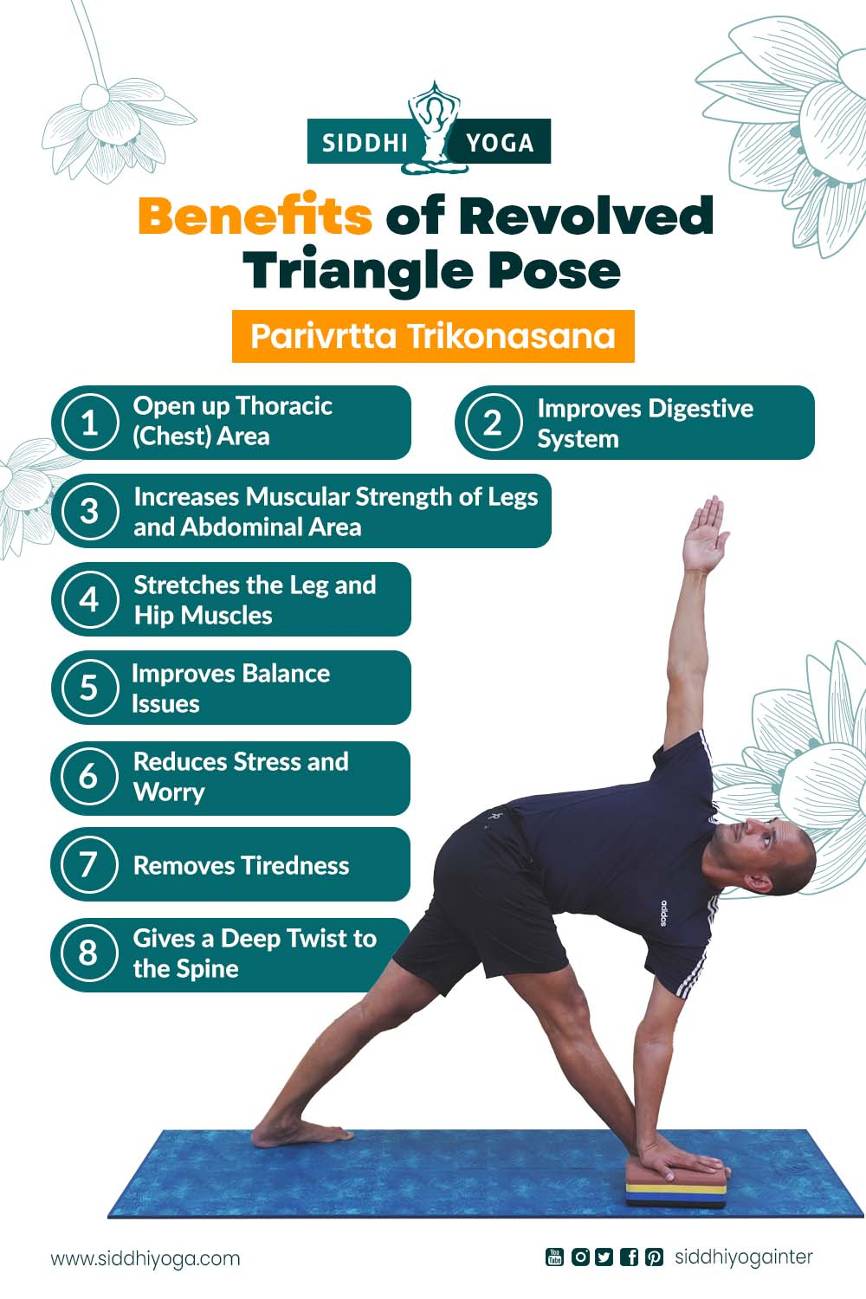
trikona: “three angle/triangle”
āsana: “posture”
Parivrtta Trikonasana at a Glance
Parivrtta Trikonasana is a powerful standing with a deep detoxifying twist pose. It is a combination of a strong foundation and a twist. This twist improves balance and stability and is a great antidote for a wandering mind. Revolved Triangle Pose teaches us to withstand the pressure of life and become powerful in all ways by being stable and strong.
Benefits:
- It helps to improve your balance and stability.
- It makes your legs, ankles, and muscles strong.
- It makes your hips, hamstrings, shoulders, and upper back more flexible.
- This Parivrtta Trikonasana improves your core strength, helps open the chest and shoulders, reduces pain and other symptoms, and improves focus.
Who can do it?
People practicing yoga and advanced-level practitioners can do the Parivrtta Trikonasana pose. Individuals with having good level of spinal flexibility can do this pose. People looking to improve their balance and stability and increase their focus level can practice the Parivrtta Trikonasana yoga pose.
Who Should not do it?
Pregnant women should avoid doing this yoga asana for the safety of both the mother and the baby. People with severe back injuries or chronic back pain should avoid this pose. Individuals with any heart issues or high blood pressure should avoid or consult their healthcare provider for guidance. Beginners should avoid doing it alone and get trained by an experienced yoga teacher.
How to Do Parivrtta Trikonasana?
Follow the Step-by-Step Instructions
Parivrtta Trikonasana (Revolved Triangle Pose) improves your concentration and awareness, as you need to stay in the present while doing the twist and full focus on your body and mind.
- Start with preparatory poses like The Revolved Lunge Pose or Standing Forward Bend (Uttanasana) and gentle stretches and warmups to maintain a safe pose.
- Stand in the Tadasana, take deep breaths, and align your back straight.
- From here, spread your legs, and the gap between your feet should be more than hip-width apart (3 to 5 feet). Here, feet should be in a straight line, and heels also be in the same line.
- Now inhale deeply and lift your arms to the shoulder level, extending outwards (as in Uthithasana), and should be parallel to the floor.
- Inhale and turn your right foot to the right side of the mat to 90 degrees. Toes should be pointing to the right side of the mat, and bring your left foot slightly inward.
- Keep your feet firm and grounded to the mat, and keep your legs and pelvic muscles engaged.
- Turn your torso (upper body) towards your right from the hip and keep your hips squared.
- Exhale and bend towards your right side (upper body parallel to the mat). Bring your left arm to the right leg and place it outside the ankle or on the yoga block if unable to reach the ankle. You can also place the palms on the floor beside your right foot.
- Raise your left arm and stretch (left shoulder over the right shoulder in one line) toward the ceiling. As you exhale, twist toward your torso (upper body) towards the right.
- Inhale and lengthen your spine, and as you exhale, turn your head to the side or look to your right arm, which is up. With each inhale, lengthen your spine, and with every exhale, you twist deeper for the Parivrtta Trikonasana pose.
- This is the final position for the Parivrtta Trikonasana and stay here for a few breaths. Keep a check over the legs, the arms, and your hips. Stay balanced and strong, and keep breathing.
- When you want to release, lower your right arm, come out of the twist and bring your hands to your hips, inhale, bring your torso up, and come to the standing position.
- Now, to balance your body, you should do this on the other side, that is, with the left foot forward and let your left hip slightly come forward and your torso twists to the left leg, and your right hand would come down to the floor or block and the left hand would be extended up to the ceiling.
What are the Benefits of Parivrtta Trikonasana?

- The twist in the Parivrtta Trikonasana (extended triangle pose) strengthens the abdominal and core muscles.
- The Revolved triangle pose helps to strengthen your legs, hips, hamstring, and spine.
- The Parivrtta Trikonasana helps the reproductive system of women as it stretches the lower back, the hip joints, and the pelvis.
- If you regularly practice the Parivrtta Trikonasana yoga, it can help to reduce back pain due to the sedentary lifestyle and add to a healthy lifestyle.
- The revolved triangle pose helps to stimulate the digestive system and help in improving digestion and daily practice may help in giving relief from constipation.
- This can help tone your abdomen and the extra fat in your waist and hips.
- Elderly people who practice yoga, like the Parivrtta Trikonasana daily, might have better sleep quality.
- The revolved triangle pose strengthens the lungs by opening up the chest through twisting movement. Those who suffer from asthma will benefit from this asana.
- Practicing this pose strengthens the neck, quadriceps, and shoulder muscles.
- Parivrtta Trikonasana pose helps to build better balance and stability in your overall body and mind and your everyday life.
- It helps you to become aware of your body and mind and improves your focus and concentration.
Health Conditions that Might Benefit from Parivrtta Trikonasana
- Regular practice of the Parivrtta Trikonasana yoga pose can be helpful for mild digestive issues as this stimulates the abdominal organs and improves digestion.
- Practicing the Parivrtta Trikonasana pose with proper alignment can help to relieve the stress and tension from your lower back and help to improve spinal flexibility.
- This pose can be helpful to people with mild sciatica pain issues.
- Practicing regularly can help to reduce the stiffness and tension in the hip region. It helps to improve your core strength and improves your body posture.
- The Parivrtta Trikonasana pose could be added to your yoga sequence routine for general flexibility and to improve overall body flexibility.
Safety and Precautions
- People with spinal and back injuries should avoid doing Parivrtta Trikonasana revolved triangle poses.
- You should avoid practicing in the condition of migraine, vertigo, and headache, as this could worsen the situation.
- People with low blood pressure should avoid doing this pose.
- Pregnant women should avoid doing the Parivrtta Trikonasana pose.
- Always do the warmup and some gentle stretches and preparatory poses before doing the Parivrtta Trikonasana pose.
- If you have any flexibility issues with your knee or hips, bend slightly to avoid the pressure.
- Be mindful and avoid forcing your body against your physical limits while performing the Parivrtta Trikonasana.
Common Mistakes
- Avoid arching or rounding your back.
- Unstable foot positioning or improper alignment of the foot.
- Distribute equal weight on both feet.
- Hands should be placed with proper alignment and the arms should be placed properly.
- Engage your core to get a better stable, and balanced pose.
- Don’t lock the front knee. You can maintain a micro bend to avoid the excess pressure on the knee joint.
- Be aware of the breath and keep it flowing till you are in the pose and avoid holding it.
Tips for Parivrtta Trikonasana
- Do warm-ups as it can prepare you for the pose.
- Keep your right and left foot firm and balanced.
- Before twisting, see that you engage your core muscles to support the spine and better balance.
- The spine should be lengthened, and don’t round your back.
- Your breath should be continuous throughout the pose.
- Before doing the revolved triangle pose, work on the hip flexibility.
- Don’t lock the front knee when you are in the twisted triangle pose.
- If you can’t reach your palms to the ground, try placing your hand on the outside of your forward leg with your forearm pressed against your shin. You can keep a yoga block or touch your ankles.
- You can gaze upward or down.
- You can do follow-up poses like The Trikonasana, Balasana, and Half Moon pose.
The Physical Alignment Principles of Parivrtta Trikonasana
- Start with the Tadasana (mountain) pose, feet width apart.
- Take your right foot on the right side, creating a gap of 3 to 4 feet in between.
- Turn the Right foot facing on the right side to a 90-degree angle.
- Left foot slightly inward.
- Square your hips, and your hips should be facing forward.
- Allow your back thigh, knee, and shin to point in the same direction as your toes.
- Engage your core muscles, and squeeze your belly muscles gently.
- Turn your torso from the hip to the right side.
- Bend from your hips (waist) as you bend forward towards your right leg and slightly bend your front leg.
- You should keep your spine straight, lift your chest, and extend it forward before you twist your torso.
- Now, remember your left palm should be placed outside the right ankle, or if it’s impossible to reach the ground or mat, you can place it on the shin or the yoga block.
- Now, the right hand should be upward, reaching the sky, and fingers pointing up.
- See that you twist from your waist and shoulders and look up to the fingers of the arm, which is up or down, whichever is comfortable.
- Keep breathing continuously in the revolved triangle pose and relax your neck and shoulders.
- Stay for 5 breaths, keeping your legs strong and your pelvic floor and lower abdominal muscles engaged, and repeat the same length of time on the other side for the Revolved Triangle Parivrtta pose.
- Follow the alignments properly for the revolved triangle pose and initially do it under the guidance of the trained yoga teacher.
Parivrtta Trikonasana and Breath
Breath is a crucial part of the Revolved angle pose for better stability and comfort. As you are ready to move into the pose, just take a deep breath, lift your chest, lengthen your spine, and extend forward. When you take a deep breath, it will help you for a deeper twist. And now, you exhale, keep your core muscles engaged to twist your torso and release the tension. Again, inhale and exhale completely and twist a bit deeper if possible. Now when you are in the revolved triangle pose, keep breathing gently to balance and to maintain the stability of the pose. Mindfulness will keep you centered and help focus on the sensations in your body. Keep breathing and connect your breath with your mind and body.
Parivrtta Trikonasana and Variations
- Yoga poses may be modified based on your individual needs.
- Parivrtta Trikonasana poses with the prop support.
- Revolved angle pose with the wall support.
- Change your arm placement (placing it on your hips instead of taking it up).
- For the challenging pose, you can clasp your hands behind.
- You can do a variation with the chair support.
Take Away
Parivrtta Trikonasana, or Revolved Triangle Pose, is a powerful standing pose with a deep twist that engages the entire body, promoting strength, flexibility, and balance. This pose helps to improve your spinal flexibility, improves your core strength, and helps with better digestion. It enhances leg strength and improves your balance and stability. It helps to improve your focus and concentration and helps reduce stress and tension. Follow the proper alignment procedure, and in case you are a beginner, do this yoga practice under the guidance of a trained yoga trainer. For any health concerns, consult your health care professional.
The revolved triangle pose increases your body awareness and you become more mindful. The twist in this pose helps to detoxify the body and connect the movement with your breath.
Unlock the door to a fulfilling career in yoga instruction with our accredited yoga teacher training courses. Choose from our foundational 200-Hrs Yoga Teacher Training Course, advanced 300-Hrs Yoga Teacher Training Course, or the all-encompassing 500-Hrs Yoga Teacher Training Course – all certified by Yoga Alliance, USA. Immerse yourself in the world of yoga philosophy, anatomy, teaching methodologies, and more. Embrace this opportunity to become a certified yoga instructor and inspire others on their path to wellness. Enroll now and embark on a transformative journey!

Could you pl mention the Chakra activated by Trikonasana ?